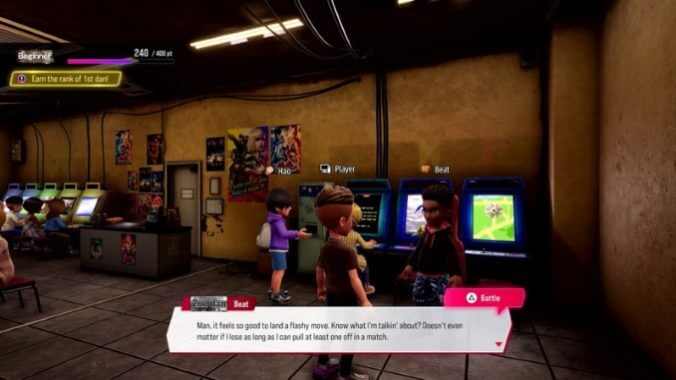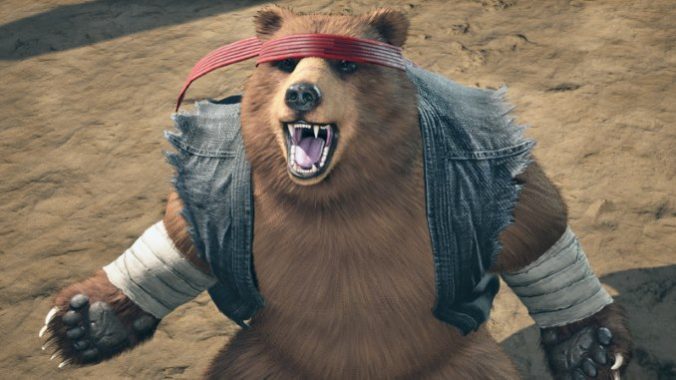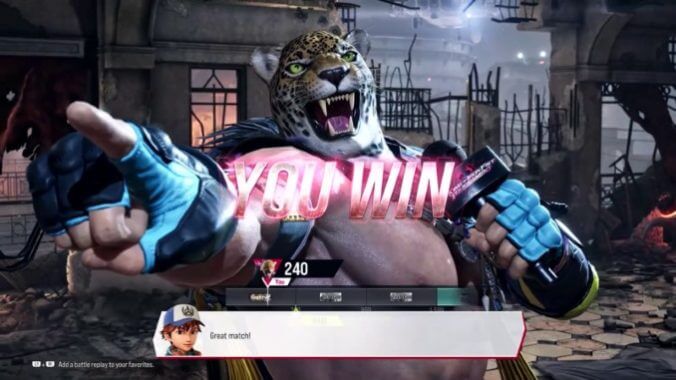Tekken Tiger Mountain (By Strategy): Paste’s Tekken 8 Preview

The first thing I did in Tekken 8 was what anybody who knows the score would do: I made my dude look rad as hell.
I dove right into that customization menu and pulled up King, the tiger-headed luchador that has been piledriving fools since the very first game back in 1994. King’s normal appearance is impeccable, as if the original Tiger Mask was an actual animal-man hybrid and not just a guy in a mask, but there’s almost always room for improvement. And with Tekken 8’s wardrobe options I was able to give King what is widely considered the absolute best fashion choice in the whole wide world of wrestling: the classic lucha combo of a mask, suit and tie. I put King in a mask that was like a cross between Jushin Liger’s and Ultimo Dragon’s: it didn’t have the wig of Liger’s, or the two huge horns that stick out at right angles from Liger’s head, but there were three smaller horns sprouting from the temples and forehead, with the middle one a little bit bigger than the other two, similar to Dragon’s mask and echoing the main central piece of Liger’s. Its orange and red color scheme made it clear this mask belonged to some kind of dragon-themed wrestler. Then I picked out a powder blue suit with a light purple tie on a cream shirt, slapped a title belt on his waist, and voila: the perfect fighting game character. Peak male apparel. A true King.
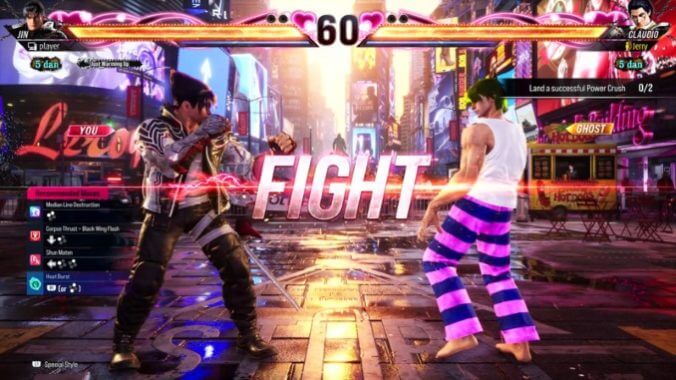
I maybe spent too much time fiddling with my little guy’s little clothes. We only had three hours during this preview event, after all, with two major modes to try out, and ideally some time spent dusting it up with the other journalists in the session. And despite how amazing my King looked, I didn’t get to see him in action for a little bit. I slid into the main story mode after picking out King’s new threads, and immediately found myself neck deep in the endless drama of the Kazama-Mishima family—with all the devil transformation and city-destroying father-son brawls that entails.
From the chapters I played last week, Jin Kazama is once again the star of the Tekken show, duking it out with his dad Kazuya Mishima and entering the King of Iron Fist tournament to save the world from his old man’s evil plans. (As Mishima says, solemnly, ominously, he hopes to “make a bloodbath of this decrepit rock,” destroying all the world’s communications and military satellites to make that just a little bit easier.) Tekken’s producers proudly touted how the series has the longest-running continuous story in videogames, something the Guinness Book apparently recognizes, and anybody who loves the infamously absurd, over-the-top action of that story can rest assured that Tekken 8 doesn’t suddenly shoot for cinéma vérité. Based on the 90 minutes or so I played of the story mode, it’s still made up of the most ridiculous plot beats, but played completely, deadly serious, which is exactly the sweet spot something like this needs to hit for maximum impact. We should absolutely laugh with Tekken’s story, but it would collapse like one of the buildings Jin and Kazuya smash each other into if the game itself didn’t treat that story with the reverence of an old Hollywood Bible epic.
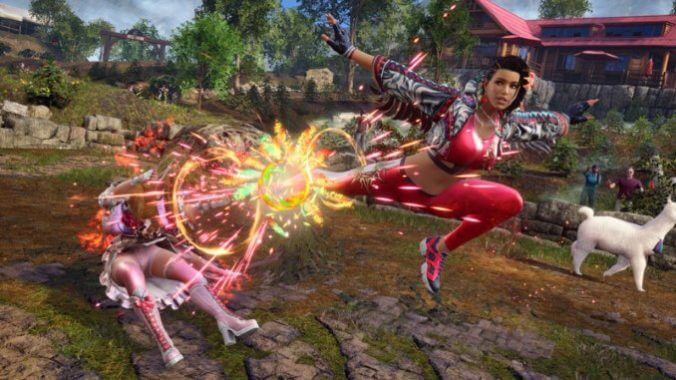
From a gameplay perspective, Tekken 8 remains focused on lightning-fast action with an emphasis on air combos. Perhaps the biggest change in Tekken 8 is the introduction of the Heat system. A blue Heat bar beneath the health meter slowly fills up as players dish out and take punishment; when activated after a “Heat Burst” or “Heat Engager” attack, a fighter hits harder and faster, doing far more damage per attack and inflicting chip damage with every blow. Two special attacks also become available, a “Heat Dash” that expands combo options, and a “Heat Smash” which deals a massive blow against the enemy. Both of those moves fully deplete the Heat meter, no matter how much is left, and since Heat can only be used once a round, it’s important to deploy it strategically and accurately. It can quickly swing a fight, making it an invaluable tool to master. Tekken 8 also boasts an optional new control scheme called Special Style that simplifies everything for newcomers. For instance, it lets players reel off combos with single button presses. It’s part of a larger movement in the fighting game world to make games mores accessible to new players, and although I’m too old to learn newfangled biz like this, it’s exactly what decades-old games like Tekken need to stay relevant for future generations.
With a huge international cast (all speaking their native language, which is unique and cool enough that I won’t even make a joke about how everybody apparently understands everybody else) and a story about solving planet-threatening geopolitical crises with a martial arts tournament, Tekken 8’s story mode feels like a cross between a big budget espionage thriller and a classic kung fu movie. The section I played at the demo exclusively featured Jin Kazama as the playable character, and took a special interest in the new character Reina, who might be a secret child of former series villain Heihachi Mishima. Given Tekken’s love of huge story swings, though, it’s entirely possible Reina is the reincarnation of Heihachi, or some kind of sci-fi situation where the rich and powerful implant their personalities and memories into younger bodies when they die, or something. The truth of Reina is clearly positioned as one of the story’s mysteries, and I won’t lie: I am a little interested in whatever her deal is.
![]()
The other mode highlighted at the demo is called Arcade Quest, and it’s much more open-ended than the story mode. It’s got some minor RPG elements, and cutesy avatars that look like big headed anime tweens who are all almost unreasonably excited about Tekken 8. It also lets players train a ghost that learns from every battle, for whenever they want to fight a computer-controlled AI version of themselves. Per the name, it’s set in a series of arcades around the world, where these Mii-looking avatars gather to play the game for fun and recognition. This is where King’s amazing new style came into play; I wiped the floor with my NPC opponents and their chosen characters, and looked amazing doing so in my crisp suit. Instead of flowing directly from fight to fight with a cutscene in between, I moved my little avatar throughout these arcades like it was a 3D adventure game, challenging other characters to fights, or just walking up to an in-game arcade cabinet.
Arcade Quest has a story as well, and like its cutesy design aesthetic it feels a little out of sync with the rest of Tekken 8. The story mode assumes familiarity with the series, with only an optional recap prepping newcomers for the madness about to come. Arcade Quest is clearly built for new players, though, not just those new to Tekken but those who might not even be familiar with the arcade experience. This was confirmed in a later interview with director Kohei Ikeda and producer Michael Murray, who explained how Arcade Quest was hoping to recreate what it felt like to play fighting games in arcades for players too young or too remote to have done that firsthand. It’s a noble goal, but one Arcade Quest might struggle to accomplish, based on the demo; unlike the photorealistic backgrounds of the matches and the large, vibrant fighters, Arcade Quest has an unpleasantly cartoonish aesthetic that jars with the rest of the game. No matter how much time and effort was spent designing Arcade Quest, its stock characters, poorly written dialogue, and awkward scenarios created an impression that it’s undercooked compared to the story mode.
